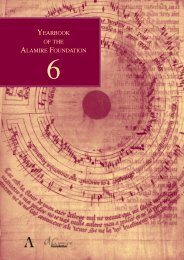programme and abstracts - Alamire Foundation
programme and abstracts - Alamire Foundation
programme and abstracts - Alamire Foundation
You also want an ePaper? Increase the reach of your titles
YUMPU automatically turns print PDFs into web optimized ePapers that Google loves.
ABSTRACTS<br />
HANNO BRAND<br />
Hanse Research Centre – Rijksuniversiteit Groningen, NL<br />
The Hanseatic Legacy: trade, town life <strong>and</strong> culture<br />
Although the Hanseatic League was one of the most elusive of<br />
all early maritime empires, it is very difficult to asses its cultural<br />
coherence. Hanseatic culture has been regarded as a spin-off<br />
effect of intense commercial exchange in a period which lasted<br />
mote than five centuries, in which the League enfolded form a<br />
loose community of individual merchants into a league of towns<br />
with impressive political influence <strong>and</strong> commercial endeavour.<br />
Although, as most <strong>and</strong> for all the historical architecture in<br />
former Hanseatic towns suggests, the League left a cultural<br />
imprint on North-western European cities, is also clear that<br />
Hanseatic merchants played only a limited role in shaping a<br />
Hanseatic civilization. Its commercial network <strong>and</strong> its ships that<br />
plied the waters of the Northern seas were the carriers of<br />
knowledge, art, architecture <strong>and</strong> music which spread through its<br />
cities. Hanseatic culture was, however, not a export product but<br />
the result of exchange between the regions along the shores of<br />
the Northern Seas. It was not contained to the Hanseatic region<br />
but bears many Flemish, Dutch <strong>and</strong> Sc<strong>and</strong>inavian influences.<br />
Nor can we assume that the area between the western Low<br />
Countries <strong>and</strong> the modern Baltic states were part of one clearly<br />
defined cultural l<strong>and</strong>scape. Modern research in fact suggests that<br />
the Hanse did not show a specific uniform cultural identity<br />
within the limits of its own region, but that it was shaped abroad<br />
within the limits of the foreign offices. Still no one will neither<br />
deny the existence of a similar language in the Hanseatic area,<br />
nor the formation of a similar commercial identity or the rise of<br />
a hanseatic town l<strong>and</strong>scape which showed many common<br />
characteristics. This paper will address the Hanse’s cultural<br />
ambiguity from a political, economic <strong>and</strong> cultural perspective. It<br />
is an attempt to show that the League, though being a very loose<br />
network of towns <strong>and</strong> merchants, owed much of its unity<br />
8











